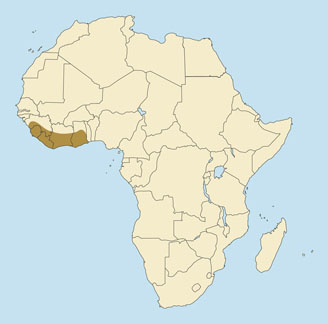 |
Neotragus pygmaeus
Antilope real (Sp), Kleinstböckchen (G), Antilope royale (F). At the time of its discovery by Europeans in 1704, this animal was reportedly called "king of the hares" by natives, hence the name royal antelope. Local hunters in Liberia refer to it as "jackrabbit," or "tricky-jack."
DESCRIPTION Shoulder height 10 inches (25 cm). Weight 4-6 pounds (1.8 to 2.7 kg).
The royal antelope is the smallest hoofed mammal in Africa and, except for the Asian chevrotains or mouse deer, in the world. It is a tiny, delicate antelope with a hunched back, pencil-thin legs, and a constantly flicking tail. Its coat is soft and sleek, golden brown in color, paler on the lower sides, with the underparts, throat and chest white. There is a brown collar across the throat and a white patch above the hoof on the front of each leg. The hind legs are longer than the front legs and are tucked under the body, which is an adaptation for fast running and jumping through dense cover. The tail is fairly long, reddish on top, with the tip and underside white. There are no lateral hoofs. Rudimentary upper canine teeth are sometimes present. The horns (males only) are tiny and smooth, with sharp points. They are set widely apart, and incline backward in the plane of the face. Females are similar to males, but do not grow horns.
BEHAVIOR Lives in pairs, possibly mating for life. Births take place November-December, the single young being weaned at about two months, and sexually mature at about 18 months. Longevity as much as six years in captivity.
Nocturnal. Feeds on leaves, fruit, some grasses, and crops if available. Apparently it does not require water. Hearing and sense of smell are thought to be better than its eyesight. When flushed, it bounds through the forest, jumping over obstacles and covering as much as eight feet (2.5 m) in one leap. The tail is generally carried tight to the body.
HABITAT High rain forest.
DISTRIBUTION Dense forest from Guinea to Ghana. East of the Dahomey Gap the royal antelope's ecological niche is occupied by the Bates pygmy antelope.
REMARKS "Tricky-jack" is well named, for it is very difficult to hunt. Even highly skilled Liberian meat hunters have little success, as it does not come to a call nor will it stand for a light. Most of the few that are taken succumb to snares or traps.
TAXONOMIC NOTES No subspecies are recognized.
|





